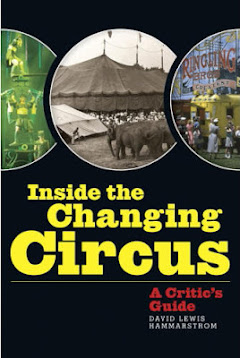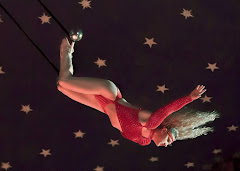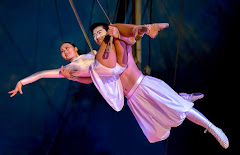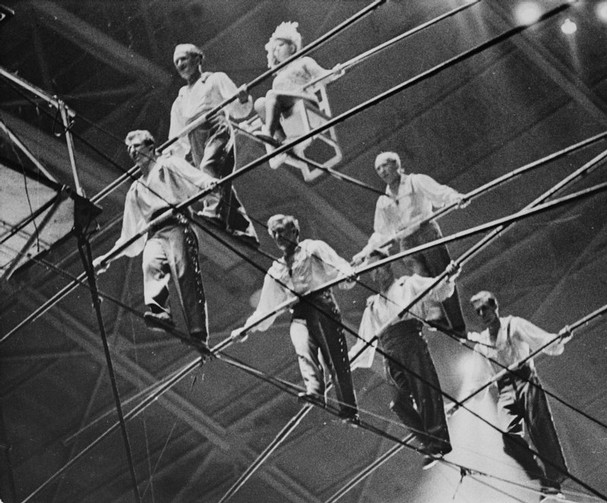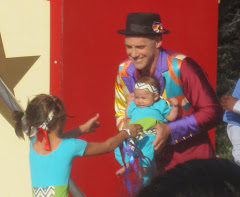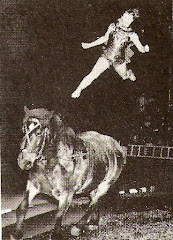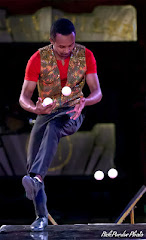I'm about at my wits end over the mere thought of Shriners in greasepaint pretending to be clowns, provoked to put out this post after being reminded of how unwanted and unwelcome they are by two reviews in the current issue of Circus Report of two different Shrine circuses -- one by Chuck Burnes on Circus Hollywood working for the Tampa Egypt Shrine; the other by Herbert Ueckert of the Osman Shrine offering at St. Paul.
Quipped Burnes, "The Shriners returned with what they thought was a funny safe-cracking routine ... the Coronas show was very good. The Shrine clowns were not."
Observed Ueckert: "The Osman Shrine clowns in a painfully long baseball gag provided an interlude of which nothing more needs to be said as readers probably are aware of this reporter's views on Shrine clowns."
Most of us would wholeheartedly agree. Considering the history of Shrine Circuses in this country, it is a shame that so many temples, by virtue of pulling the strings and using the "producers" more as booking agent whores than producers, continue to subject the public to the slipshod, half-baked programs they themselves produce.
How does Shrine clowning hurt the circus business? Assuming for a moment that by "business," I am referring to "entertainment," let us count some of the ways:
* Audiences are not fooled. Audiences sympathetic to worthy Shrine causes may refrain from expressing discontent, but the embarrassing spectacle of a Shrine "clown alley" may resonate for years in their collective memories.
* Less opportunities for professional clowns -- what's left of them. Feld Entertainment, to its credit, trains many young jesters; then, where next for them? I can't recall in my youth ever going to a Shrine circus that did not include some of the best clowning in the country. The mere thought of a bunch of Shriners giving themselves free reign, coupled with obscenely long concession-revenue-producing intermissions, leaves me with virtually no desire ever to step into a Shrine circus again. And to think, the first truly great circus performances I witnessed were produced by Polack Brothers for Shrine temples from coast to coast.
* Less incentive for younger clowns to stick with it. If an aspiring clown sees fewer circuses actually hiring professional fun makers, what will that do for his/her motivation? Self-esteem? Pride of profession? Imagine how this must affect the ambitiously creative team of Steve Copeland and Ryan Combs at moments when they, as well they will during the course of their careers, contemplate opportunities away from Kelly Miller Circus? Where, indeed, would they go? The tent shows, thankfully, are still open to hiring clowns. Indoors for the Shriners? I cry picturing those guys having to share the rings with a bunch of self-deluded amateurs.
* Deprives the public of a key element in a good circus program: Clowns who make people laugh in clever unexpected ways.
* Denigrates nearly to zero the once-great, once respected "Shrine Circus" name.
What can be done? Bottom line, nothing can be done -- unless and until the producers themselves were to refuse allowing into the programs they allegedly "produce" these clunsy overblown bores.
As Chuck Burnes noted, "But there's nothing anyone can do if they want to keep their contract."
A vicious cycle. Contract kept. Another mucked up mediocre performance the result.
Need any of us wonder why fewer and fewer Shrine temples are even trying to put out a circus anymore? I feel no sympathy whatsoever for their diminishing number, considering the harm they are visiting upon the image of circus art in America.
Cry, clown, cry.
Friday, May 18, 2012
Friday, May 11, 2012
Circus Pinder, Can We Be Friends?
I was surfing YouTube land, as sometimes I do. My friend Dame Dither, currently luxuriating in a summer retreat west of Santa Rosa, sent me a link to an acro-ballet contortion-duo, man and woman offering flawless executions combining equilibristics (WHY does that word never appear in a dictionary???) and erotic posturing. Stress erotic -- sex spelled s-e-x sells, right? This one got steamy hot, which suggests yet another arena for further development among the nouveau set (spell checker won't accept "nouveau" either). The crowd was taken. The crowd was French. Perhaps a competition. Seats packed with the well healed. I watch these lyrical contortions with numbing ambivalence, for they are a little too preciously insular for my taste. In other words, too slow. These are those moments were advanced circus art comes the closest to making authentic inroads into the more abstract world of ballet -- when tautly controlled perfection in a "circus" type setting can feel slightly still born.
At the finish of this video appeared, of course, links to other YouTubes of like kind (it's Friday evening, and what else have I to do?), so, here comes serendipity on demand: I watched one Terry Lemas attempt a triple; she accomplished it, though it appeared as if she and the catcher were locking arms rather than wrists; and upon her return to the fly bar, she missed, into the net. I did admire her stamina.
Then onto another act, the Flying Mendocas, who did lots of things, though most of them fun and flashy and not too memorable, and, from there, finally to one Circus Pinder. Embarrassed to say (fearing the Europeans may disown me), only this much I know about Circus Pinder: I'd heard the name. [blame it, please, on my loyal aversion to flying in airplanes.] Anyway, this 12-minute Circus Pinder sampler caught my attention. Some nice if not spectacular acts yet full of animation and zest. A diablo guy who ended up so joyfully proud of himself, making such an immediate connection with the audience as to give me a true circus high. Two clowns with instruments -- a third stood by with violin at the ready -- made me laugh out loud (high water mark) because of the funny, socially embarrassing sounds related to body functions that their instruments produced when provoked by each other. There were camels and horizontal bars (how I've missed horizontal bar acts). Some Asian kids, all of only a few seconds; they must have been good, I wanted to assume. Suave voice of a ringmaster discretely in the background just right. Music at least added to the infectious spirit of the show. From just these few snippets, it's a circus I would love to see.
That's all.
At the finish of this video appeared, of course, links to other YouTubes of like kind (it's Friday evening, and what else have I to do?), so, here comes serendipity on demand: I watched one Terry Lemas attempt a triple; she accomplished it, though it appeared as if she and the catcher were locking arms rather than wrists; and upon her return to the fly bar, she missed, into the net. I did admire her stamina.
Then onto another act, the Flying Mendocas, who did lots of things, though most of them fun and flashy and not too memorable, and, from there, finally to one Circus Pinder. Embarrassed to say (fearing the Europeans may disown me), only this much I know about Circus Pinder: I'd heard the name. [blame it, please, on my loyal aversion to flying in airplanes.] Anyway, this 12-minute Circus Pinder sampler caught my attention. Some nice if not spectacular acts yet full of animation and zest. A diablo guy who ended up so joyfully proud of himself, making such an immediate connection with the audience as to give me a true circus high. Two clowns with instruments -- a third stood by with violin at the ready -- made me laugh out loud (high water mark) because of the funny, socially embarrassing sounds related to body functions that their instruments produced when provoked by each other. There were camels and horizontal bars (how I've missed horizontal bar acts). Some Asian kids, all of only a few seconds; they must have been good, I wanted to assume. Suave voice of a ringmaster discretely in the background just right. Music at least added to the infectious spirit of the show. From just these few snippets, it's a circus I would love to see.
That's all.
Thursday, May 03, 2012
At the Editor's Desk, "Bandwagon" Magazine Changes Freds -- From Pfening to Dahlinger
Fred D. Pfening III, who assumed editorship of the Circus Historical Society’s Bandwagon following the passing of his father, Fred D. Jr, seemed the perfect successor. But he is walking off the lot after only 18 months, or nine issues, under the tent. I feel a tinge of regret, although I am not all that surprised.
When the moment was his, Pfening III accepted the position under a cloud of reluctance. Something like "for now." More ominous still, the issues he edited straggled into the mail later and later. When Pfening III's final issue, numbered November-December 2011, arrived in my mail box over three months late, I said to myself. Ohio, we have a problem.
At least, let's hope, the late delivery problem may disappear when new editor Fred Dahlinger, Jr. assumes full control.
Nonetheless, I feel provisionally sorry that Pfening III is gone because, on balance, he seemed a natural to continue the welcome mix of serious and light material that his father published — even if, at times, he revealed a somewhat troubling penchant for favoring the arcane in heavy doses. I’ve, honestly, not felt as engaged lately as I did earlier.
In an editor's note explaining his exit, wrote Pfening III, "I never shared my dad's love of editing. My passion has always been researching and writing about circus history."
That makes perfect sense. At his best over the years, Pfening III would find articles from decades back that shed light on interesting issues, even if some of his finds, by virtue of their having originally been crafted for popular media (remember magazines, anybody?), were more likely to be riddled with errors.
One of them, a page-turning tale that borders on tabloid, “The Mad Love of Alfredo Codona,” which arrived in the latest issue (see the post below), strikes me as a perfect candidate for more critical editorial scrutiny up front. Pfening, in his preface to the piece, acknowledges “a few factual errors.” The real questions is, minor or major? The article might be a major spin job by the mother of circus star Vera Bruce, not nearly as innocent as her mother would have us believe.
I'm glad to find it there, but I would have liked more perspective on the story's validity.
Might new editor Dahlinger, Jr. (now working on the January-February issue), have struck a more skeptical view in a preface had he published the Codona tale? .
Several years ago, Pfening III brought to our attention an expansive piece about the reception accorded Barnum & Bailey’s first three ring circus in New York. In his preface, curiously Pfening lavished puzzling praise on reviewer Edward Hoagland, whose notice is clearly a work of triumphal everything-is-fine at the circus prose. Another review in the same story reveals a savvy New York critic taking a candid look, which itself constitutes a valuable contribution to history.
So these finds of Pfening III’s were rich in primary research; I hope he continues apace as back to the status of contributor he goes.
How might Bandwagon change under Dahlinger's direction? Hard yet to tell. He certainly enjoys widespread respect for his apparently encyclopedic knowledge of circus history, and so we can only wonder how he will apply it to the articles submitted to him for publication, and how he will treat those that contain significant nuggets worth publishing and are yet riddled as well with misinformation. Dahlinger's preference for excessive cross-referencing and accuracy (not always on display in the epic picture book Circus: 1870-1950, for which he reportedly was recruited as a master fact checker) may prove beneficial -- or a hindrance.
There is reason to wonder if Dahlinger will turn Bandwagon into Monograph City. He has a way of answering questions with lengthy dissertations, for which there is perhaps an appreciative audience, but not as great a one as there is for the more easily readable fare, such as Lane Talburt’s series on Pete Cristiani and his family, or Bill Taggart’s yet-to-be-completed series on his work as a ticket seller with Ringling-Barnum during its last under-canvas years, complete with revelations of petty grifting at the ticket window and on the inside against the customer.
In a good move I think, Pfening III dropped the annual season round-up story that was so randomly organized as to leave me only faintly engaged; Better yet, in my opinion, would be a George L. Chindahl approach, alphabetically organized, to a listing of every circus on the road, with precise component information as to such things as number of performances, dates, size of show, owners, size of band if any, etc. Facts. Facts, Facts.
Lastly, book reviews: Since Bandwagon's main focus is history, its editors and contributors should be in the best position to weigh in on the historical accuracy of new books. It is hard to understand why this has not all along been a regular feature. Circus Report, to its credit, appears to cover new books, from what I have seen, only having recently re-subscribed.
All of the above having been said, I am still surprised, or should I say disappointed, that Pfening III walked off the lot. This means that the Pfening reign, which lasted over half a century, is now over.
Perhaps the best to hope for is the continuation of the magazine itself. Dahlinger is a formidable and serious force, and so theoretically the magazine falls into trustworthy and competent hands. Like virtually every aspect of the American circus world from shrinking tents to shrinking fan magazine subscriptions, Bandwagon operates in near obscurity; it has few takers, but it somehow troupes admirably on, from one shaky season to the next.
When the moment was his, Pfening III accepted the position under a cloud of reluctance. Something like "for now." More ominous still, the issues he edited straggled into the mail later and later. When Pfening III's final issue, numbered November-December 2011, arrived in my mail box over three months late, I said to myself. Ohio, we have a problem.
At least, let's hope, the late delivery problem may disappear when new editor Fred Dahlinger, Jr. assumes full control.
Nonetheless, I feel provisionally sorry that Pfening III is gone because, on balance, he seemed a natural to continue the welcome mix of serious and light material that his father published — even if, at times, he revealed a somewhat troubling penchant for favoring the arcane in heavy doses. I’ve, honestly, not felt as engaged lately as I did earlier.
In an editor's note explaining his exit, wrote Pfening III, "I never shared my dad's love of editing. My passion has always been researching and writing about circus history."
That makes perfect sense. At his best over the years, Pfening III would find articles from decades back that shed light on interesting issues, even if some of his finds, by virtue of their having originally been crafted for popular media (remember magazines, anybody?), were more likely to be riddled with errors.
One of them, a page-turning tale that borders on tabloid, “The Mad Love of Alfredo Codona,” which arrived in the latest issue (see the post below), strikes me as a perfect candidate for more critical editorial scrutiny up front. Pfening, in his preface to the piece, acknowledges “a few factual errors.” The real questions is, minor or major? The article might be a major spin job by the mother of circus star Vera Bruce, not nearly as innocent as her mother would have us believe.
I'm glad to find it there, but I would have liked more perspective on the story's validity.
Might new editor Dahlinger, Jr. (now working on the January-February issue), have struck a more skeptical view in a preface had he published the Codona tale? .
Several years ago, Pfening III brought to our attention an expansive piece about the reception accorded Barnum & Bailey’s first three ring circus in New York. In his preface, curiously Pfening lavished puzzling praise on reviewer Edward Hoagland, whose notice is clearly a work of triumphal everything-is-fine at the circus prose. Another review in the same story reveals a savvy New York critic taking a candid look, which itself constitutes a valuable contribution to history.
So these finds of Pfening III’s were rich in primary research; I hope he continues apace as back to the status of contributor he goes.
How might Bandwagon change under Dahlinger's direction? Hard yet to tell. He certainly enjoys widespread respect for his apparently encyclopedic knowledge of circus history, and so we can only wonder how he will apply it to the articles submitted to him for publication, and how he will treat those that contain significant nuggets worth publishing and are yet riddled as well with misinformation. Dahlinger's preference for excessive cross-referencing and accuracy (not always on display in the epic picture book Circus: 1870-1950, for which he reportedly was recruited as a master fact checker) may prove beneficial -- or a hindrance.
There is reason to wonder if Dahlinger will turn Bandwagon into Monograph City. He has a way of answering questions with lengthy dissertations, for which there is perhaps an appreciative audience, but not as great a one as there is for the more easily readable fare, such as Lane Talburt’s series on Pete Cristiani and his family, or Bill Taggart’s yet-to-be-completed series on his work as a ticket seller with Ringling-Barnum during its last under-canvas years, complete with revelations of petty grifting at the ticket window and on the inside against the customer.
In a good move I think, Pfening III dropped the annual season round-up story that was so randomly organized as to leave me only faintly engaged; Better yet, in my opinion, would be a George L. Chindahl approach, alphabetically organized, to a listing of every circus on the road, with precise component information as to such things as number of performances, dates, size of show, owners, size of band if any, etc. Facts. Facts, Facts.
Lastly, book reviews: Since Bandwagon's main focus is history, its editors and contributors should be in the best position to weigh in on the historical accuracy of new books. It is hard to understand why this has not all along been a regular feature. Circus Report, to its credit, appears to cover new books, from what I have seen, only having recently re-subscribed.
All of the above having been said, I am still surprised, or should I say disappointed, that Pfening III walked off the lot. This means that the Pfening reign, which lasted over half a century, is now over.
Perhaps the best to hope for is the continuation of the magazine itself. Dahlinger is a formidable and serious force, and so theoretically the magazine falls into trustworthy and competent hands. Like virtually every aspect of the American circus world from shrinking tents to shrinking fan magazine subscriptions, Bandwagon operates in near obscurity; it has few takers, but it somehow troupes admirably on, from one shaky season to the next.
Tuesday, May 01, 2012
Unlimited Thread, Continued: Who Drove Love-Starved Alfredo Codona Mad -- Vera Bruce or Alfredo Codona?
 Bandwagon’s last issue to be edited by Fred. D. Pfening III features a page-turning story by the mother of circus star Vera Bruce (seen here with Codona, left), from the May 1938 issue of True Story magazine. In it, the trapeze god is depicted as a tragically self-deluded man, who began pressing Vera to date him while his wife Lillian Leitzel was away performing in Copenhagen for two weeks in 1931.
Bandwagon’s last issue to be edited by Fred. D. Pfening III features a page-turning story by the mother of circus star Vera Bruce (seen here with Codona, left), from the May 1938 issue of True Story magazine. In it, the trapeze god is depicted as a tragically self-deluded man, who began pressing Vera to date him while his wife Lillian Leitzel was away performing in Copenhagen for two weeks in 1931.Brazenly, only days before Leitzel’s fatal fall, according to this sensational account, Codona was pursuing Bruce like a hungry animal starved for affection (or would that be lust?) “You know you are going to belong to me, so why make all this fuss?” he insisted.
Unlike most of us with half a brain cell and know that you can't talk somebody else into loving you, or yourself into loving them, Codona apparently would not take no. He comes off looking incredibly stupid and self-deluded. Bruce's mother, Annie Bruce, blames it on Codona's having been able to get whomever he wanted, which I doubt.
"Mary me and I will teach you to love me,” he tells Vera once Leitzel is gone. Bruce insists she does not love him and likely never will, and still, he persists. At last, Bruce surrenders. But her attitude remains romantically indifferent: “I don’t love you, Alfredo. I respect you but I don’t love you.”
When Alfred is grounded from a career-ending injury, we can only imagine Vera finding him even more pitiful. Five years into the marriage, and she files for divorce. While Alfredo meets alone with his ex-wife to be in a Long Beach lawyer's office, Codona pulls out a gun, shoots Vera dead and then turns the gun on himself.
That simple? There is a totally different account offered by equestrian director Fred Bradna in his book Big Top (itself, I must warn you, not always accurate). In quick summation, here is Bradna's take: “Miss Bruce derived satisfaction from thrusting the knife into a woman [Leitzel] to whom she must always defer professionally. To steal Letizel’s husband was a triumph for her.”
My take: Marriage was a rocky road for Leitzel and Codona. I compare Lillian's looks anatomically speaking, to Vera's, and find it enormously easy to believe that Vera, conniving or not, lured Alfredo away in a state of near-uncontrollable passion -- a passion he may never have felt for the comparatively plain Leitzel. After Alfredo suffers a career-ending injury and is sidelined doing less-glamorous jobs, he becomes even more pitiful in Vera's callous eyes. Sorry Mama Anna Bruce: I don't quite buy your very moving account.
Next down this rocky road: An ambivalent farewell to the Pfening Bandwagon.
Subscribe to:
Posts (Atom)




